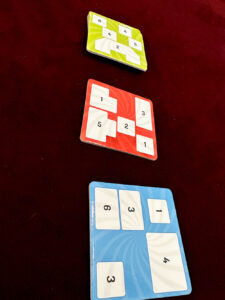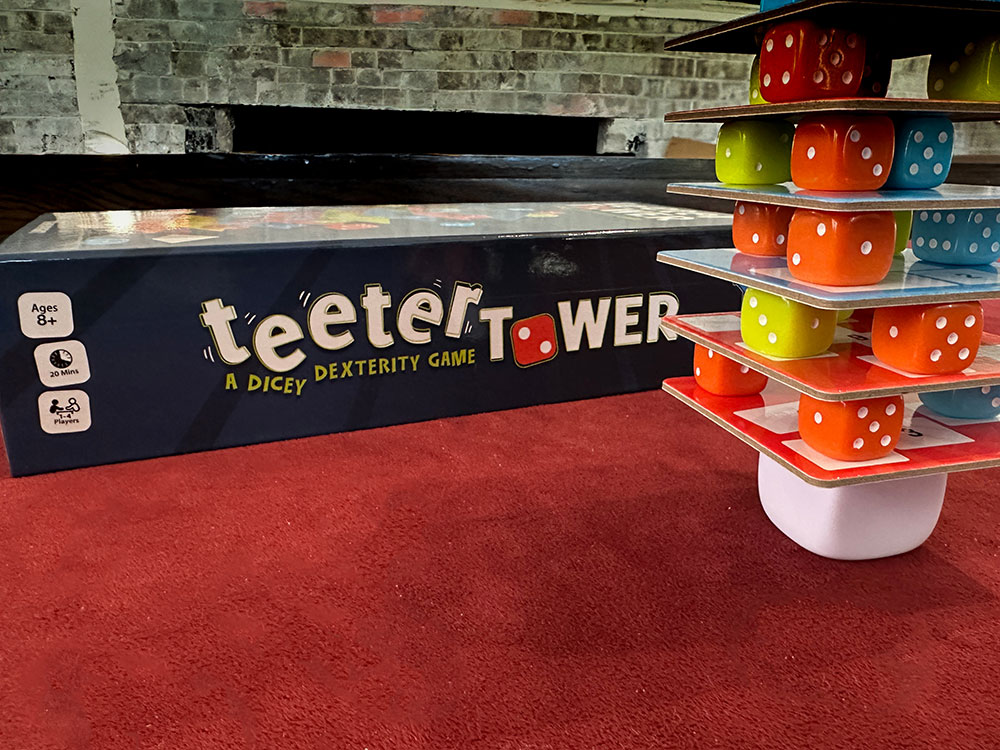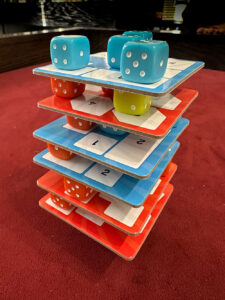 Dexterity games are always a hit around BGQ and Teeter Tower looked like it would fit in well as a 20-minute family friendly stacking game. Who doesn’t love testing their hand-eye coordination and trying to do that whole “hold your arm with the other hand trying to keep it from quivering as you put a die on the tile” thing?
Dexterity games are always a hit around BGQ and Teeter Tower looked like it would fit in well as a 20-minute family friendly stacking game. Who doesn’t love testing their hand-eye coordination and trying to do that whole “hold your arm with the other hand trying to keep it from quivering as you put a die on the tile” thing?
And if you just play things perfectly you might get a chance to add the capstone tile and marvel at the beauty of your tower. Leaning, teetering, structurally sound? Doesn’t matter if it doesn’t fall. But it will likely fall. Often.
Gameplay Overview:
In Teeter Tower players will be attempting to stack tiles and dice without making everything fall over. It is essentially a cooperative reserve Jenga. But there are of course a lot of restrictions to make things not as stable as you might like.

You will start the game with four tiles of each color (blue, green, and orange) in stacks of matching colors such that only one of each is available. Then you’ll roll four dice pulled randomly from a bag. The dice come in three colors and match the available tiles. You can choose any of the three available tiles to place and then can place dice on the tile to support the next level.
However, you can’t just put the dice anywhere you want. The tiles have some white areas with numbers and also some non-numbered colored areas. The die you place must either match the color or number of the area of the tile it’s placed in. You must place at least one die but obviously more will give you a better structure as the game moves on.
It’s worth mentioning, the first tile is placed on a roughly 1” cube and built up from there. So, the “teetering” part of Teeter Tower is apparent from the very beginning. You win the game by successfully placing all twelve colored tiles and then adding a capstone tile and dice to the very top. There are rules for harder difficulty which include more tiles and placing them at angles rather than square the level below.

Game Experience:
Teeter Tower, on paper, is exactly what I want my dexterity games to be. Easy to explain, quick to play, and good for families to jump right in. It fulfills basically all those fronts and we had a great time playing with parents, children, and board gaming friends.

What we didn’t get to experience though… was winning. Teeter Tower is hard. Very hard. Much harder than it really should be. Some of that comes down to just the number of levels required and you could easily start with fewer than the 12 tiles the game suggests if you are a rule-breaking type. But more so than that sometimes you just roll dice in such a way that none of the tiles will give you much support. Maybe a tile could only accept one or two dice or only would allow your dice to be on one side of the tile. Your structure will fall soon, if not immediately.
It is somewhat of a bummer to lose when you’ve only been able to add two or three tiles to your tower before the dice ruin everything. It’s fortunate that the game is quick enough to not feel too bad about just having to start over a couple of minutes in. But the real fun in cooperative games, at least for me, is nearing the end and teetering on the brink of success.
There could be some improvements with some sort of dice mitigation rules. Some flexibility there might allow the higher levels of difficulty to be easier to at least experience and provide a more rewarding ending to most of the games. That said, my son and I enjoyed playing this several times over a couple of days. And not to place all the blame on my son’s 9-year-old shoulders, I lost just as badly playing with groups of adults.
Final Thoughts:
If you’ve got your engineering degree or just want a very challenging dexterity game, Teeter Tower is perfect for you. It is quick to play (under 20 minutes) and easy to explain. If you want an easier experience it’s fairly easy to house rule to be even easier than the novice difficulty in the rulebook.
For my family, the die rolling luck was just too punishing, and too often we found ourselves losing when we weren’t even halfway through the tiles we had to place. The tension of those last few tile placements are almost for sure the best moments but we just didn’t get to experience them. That said, we enjoyed playing a few games every now and then even if we didn’t get very far.
Final Score: 3 Stars – Simple, quick, and fun. But too difficult for a family game.
 Hits:
Hits:
• Quick to learn and play
• Fun despite losing so much
Misses:
• No mitigation for dice rolls that will doom your tower.
• Difficulty scaling starts too hard and just gets impossible.
Source: Board Game Quest





